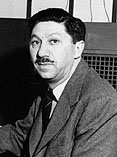
Personality Assessment
Understanding ourselves and our relationships
Following the introductions to several models and theories in our last issue, we will now consider
Co-Counselling and
As previously we will provide brief introductions in this section, and follow this by articles showing how some of these models are used in practice.
It should be noted that the inclusion of any specific model in this section does not imply its unqualified acceptance by Nurturing Potential, merely that we recognise the contribution it has made to the body of knowledge in this area. Indeed, we both provide - and invite from others - sceptical responses.

Abraham Maslow - 1908-1970
"When
the only tool you have is a hammer,
you tend to see every problem as a nail."¶
Abraham Maslow considered that human beings are motivated by unsatisfied needs, and that these have an order of priority. The lower needs demand satisfaction before higher needs can be satisfied. Maslow based his studies upon role models such as Albert Einstein, Abraham Lincoln, Martin Buber, and Albert Schweitzer rather than mentally disturbed or neurotic patients.
Working in this way involved a radical departure from the mainstream theories of psychology with which he had grown up, such as the psychoanalytical school of Freud and the behaviourist beliefs of Skinner. Freud, for example, saw little to differentiate the basic motivations of humans from those of lower animals; although we are considered to be an intelligent and rational life form, we regularly fail to display these tendencies. Maslow considered that this depressing view of people came from Freud's study of mentally disturbed and psychotic people. In Motivation and Personality he wrote: "The study of crippled, stunted, immature, and unhealthy specimens can yield only a cripple psychology and a cripple philosophy"
The behaviourists such as Skinner, on the other hand, used motivational models such as birds, dogs and rats, studying the way their learning was based on a simple reward system and the avoidance of pain. It was Maslow's contention that psychologists would benefit more from studying the playfulness and affection of animals, and pay more attention to individual differences rather than treat people as falling into statistical categories.
To call attention to the differences between his optimistic view and their denial of human freedom and dignity, he labeled his approach the "Third Force." He was convinced that when scientists finally examined the noble examples of human development, they would discover that people are basically trustworthy, self-protecting, and self-governing.
He considered that violence arose from deprivation and not from a basically violent human nature.
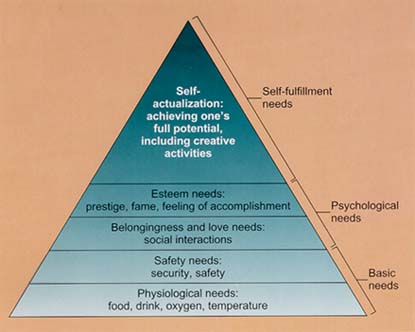
Four general types of needs must be satisfied before a person can act unselfishly: in the Hierarchy of Needs diagram (above) these are, in ascending order, physiological, safety, love and esteem, with self-actualization the pinnacle towards which the individual aspires. Maslow called these needs "deficiency needs". To satisfy our needs is healthy; to block them is what makes us sick or wicked. We are, in effect, addicted to our needs and this addiction must be satisfied to avoid sickness, in the same way that a heroin addict's cravings demand satisfaction.
Needs are prepotent, which means they have an order of priority, or, in psychological terms, produce the greatest stimulus when stimuli with conflicting responses occur together. We all have different or differing prepotent needs. An addict's prepotent need will be to satisfy a craving. A member of a group may have a prepotent need for group acceptance. The addict, in a group, will be more concerned about satisfying the addiction than being accepted by the group. According to Maslow, a person's prepotent need is the lowest unmet need in the pyramid.
It is only when the deficiency needs are met that other - higher - needs require satisfying; and when these are satisfied, new - still higher ones - emerge.
Physiological Needs
Physiological needs are the very basic needs such as air, water, food, sleep and sex. When these are not satisfied we may feel sickness, irritation, pain or discomfort. These feelings motivate us to alleviate them as soon as possible to establish mental and physical stability. Once they are alleviated, we may think about other things.
Safety Needs
Safety needs have to do with establishing equilibrium and consistency in a chaotic world. These needs are mostly psychological in nature. We need the security of a home and family. However, if a family is dysfunctional, if, for example, a wife is abused by her husband, the wife cannot move to the next level because she is constantly concerned for her safety. Love needs are subordinated by her feelings of fear. Nowadays many people, particularly those in the inner cities, are stuck at this level, scared to go for a walk in their neighbourhood.
Love Needs
Love and belongingness are next on the ladder. Humans have a desire to belong to groups: clubs, work groups, religious groups, family, gangs, societies. We need to feel loved (non-sexual) by others, to be accepted by others. Performers appreciate applause. We need to be needed. Television commercials - indeed, advertising generally - plays on this need for acceptance, for belongingness, for love.
Esteem Needs
There are two types of esteem needs. First is self-esteem which results from competence or mastery of a task. Second, there's the attention and recognition that comes from others. This is similar to the belongingness level, however, wanting admiration has to do with the need for power. People who have all of their lower needs satisfied, often drive very expensive cars because doing so raises their level of esteem.
Self-Actualization
The need for self-actualization is "the desire to become more and more what one is, to become everything that one is capable of becoming." People who have everything can maximize their potential. They can seek knowledge, peace, esthetic experiences, self-fulfillment, oneness with God. Peak experiences are profound moments of love, understanding, happiness, or rapture, when a person feels more whole, alive, self-sufficient and yet a part of the world, more aware of truth, justice, harmony, goodness. Self-actualizing people have many such peak experiences.
References:
Abraham H. Maslow, Motivation and Personality, 2d ed., Harper & Row, New York, 1970.
Booklist:
Towards a Psychology of Being, Abraham H. Maslow, Richard Lowry (Editor), John Wiley, 1998
Religions, Values, and Peak-experiences, A. Maslow, Atlantic Books, 1994
The Maslow Business Reader, Abraham Maslow, Deborah C. Stephens (Editor), John Wiley, 2000
Third Force: Psychology of Abraham Maslow, Frank G. Goble, Pocket Books, 1984
The
Right to be Human: A Biography of Abraham Maslow, Edward Hoffman, PhD,
Aquarian, 1989
You may be surprised at the number of quotations you already know, without knowing they are attributable to Maslow. Click here to read them.
You will find a sceptical response to this theory via our Main Theme pages or directly at Sceptic.htm
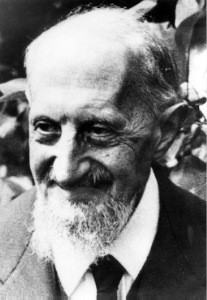
Roberto
Assagioli - 1888 - 1974
Psychosynthesis
, developed around 1910 by Roberto Assagioli, has as its focus the attainment of synthesis, a coming together, of the various parts of an individual's personality into a more cohesive self. It believes each of us has an innate drive toward the unfolding of ourselves, and that we can choose to consciously support that process.That person can then function in a way that is more life-affirming and authentic. Psychosynthesis is also concerned with the "higher" or "transpersonal" self as being an affirmation of the spiritual dimension of the person. The higher self is seen as a source of wisdom, inspiration, unconditional love, and the will to meaning in our lives.
Psychosynthesis is founded on the basic premise that human life has purpose and meaning and that we participate in an orderly universe structured to facilitate the evolution of consciousness. A corollary is that each person's life has purpose and meaning within this broader context and that it is possible for the individual to discover this.
One of the strengths of psychosynthesis is that it provides practical methods to recognize and access the "higher" or "deeper" part of ourselves, so that the process of growth happens according to an "inner wisdom." What this also means, is that in accessing this truly empowering part of ourselves, the person's own inner self is not violated or imposed upon. It is allowed to unfold at its own speed, and according to its own pattern. It honours all parts of our being, enabling the working through of blocks that hinder growth, without creating further blocks in the process.
The "Egg" Diagram
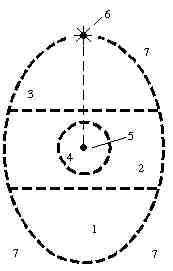
1. The Lower Unconscious
2. The Middle Unconscious
3. The Higher Unconscious or Superconscious
4. The Field of Consciousness
5. The Conscious Self or "I"
6. The Higher Self
7. The Collective Unconscious
Assagioli's original "egg" diagram offers a view of the human psyche in its many aspects. The layers of the unconscious include: the lower unconscious, the arena of repressed and traumatic memories, fundamental drives and impulses, and elementary psychological functions; the middle unconscious which is formed of psychological elements similar to those of our waking consciousness and easily accessible to it.; the higher unconscious carrying the elements of transpersonal experience; and the collective unconscious, defined primarily by Jung as the unconscious that carries archetypal experiences.
The varying layers of unconsciousness are noted
with dotted lines indicating the permeability and non-rigidity of these states,
and likewise the fields of consciousness, that awareness that an individual may
have in any moment is also not a fixed point.
The Self, in this map, is viewed as both the "I", a center of
awareness and will anchored within the personality and the Higher Self, the
center of awareness and will anchored in the transpersonal dimension and
accessing both personal and universal experience.
In versions of the "egg" diagram that have followed Assagioli's
original model, the Higher Self star has been removed, or it has been drawn
surrounding the egg, or with an equivalent "star" located opposite the
Higher Self in the lower unconscious sphere. Each of these versions points to
the awareness that the Self exists in all areas of the psyche, that as the
ground of being and the source, it is not only accessible in "higher"
experiences but also in everyday life (middle unconscious) and in the depths of
the experience of darkness (the lower unconscious) .
The "Star" Diagram

Assagioli's "Star" maps the relationship of psychological functions to the will and the Self. The functions of the Self are awareness and will and it is through the interaction of will and the various functions that we interact in the world. The variety of functions allows us to note how complex and at the same time unique each person is, for each individual relies differently on the various functions, operating with strength in some areas and with weakness in others. This map also denotes the ways we have of creating change. An impact on any psychological function may begin a process that changes the whole person. Techniques in psychosynthesis, likewise, draw on the various functions. Assagioli's "psychological laws pertaining to will training" offer an elaboration of the processes by which change is created. For instance, his first law states that "images or mental pictures and ideas tend to produce the physical conditions and the external acts that correspond to them." The gift of this map is its vision of the wholeness and richness of the human being with the certainty that growth is possible.
Psychosynthesis has had a profound impact on the human potential movement. For example, the use of guided imagery and the concept of subpersonalities originate in Psychosynthesis.
Booklist:
Roberto Assagioli, Transpersonal Development, Crucible, London, 1991
Roberto Assagioli, Psychosynthesis, Thorsons, London, 1993
Robert Assagioli, The Act of Will, Thorsons, London, 1994
Will Parfitt, The Elements of Psychosynthesis, Element Books, 1990
John Rowan, Subpersonalities, Routledge, London, 1990
Neuro-Linguistic Programming (NLP)
The first part of of this introduction has been taken from the first edition of Joe Sinclair's An ABC of NLP published in 1992, being his simple definition of NLP. The rest of the introduction is mainly taken from the second edition of An ABC of NLP (1998) to which Stephen Bray generously contributed. Following the introduction we have provided some sceptical responses.
Neuro-Linguistic Programming was so named because it is based on the study of how behaviour stems from the neurological processes, how language is used in communication, and how we programme our behaviour and ideas. A set of tools for identifying and modelling human excellence, and a process for developing models, it has been simply defined as the study of excellence.
NLP is not itself a psychotherapy. It is an extremely powerful tool, however, for providing understanding of human experience and activity, and, when it is used in therapeutic concerns, it can be an extremely effective technique for change in human behaviour and capacities, as well as improvement in communication, although, as Richard Bandler has stated, "NLP is not a set of techniques, it's an attitude."
In essence NLP is a modeling system which was developed in the early 1970s by people whose background comprised cybernetics, mathematics and linguistics. John Grinder and Richard Bandler were both at the University of California, Santa Cruz; the former an assistant professor of linguistics, the latter a student of psychology and a mathematician. Modeling, in the context of NLP, is the process of discovering exactly and specifically how people produce their best results, and replicating them.
It is based on the assumption that since we all share the same neurology, we can successfully replicate anyone else if we follow their actions and behaviours precisely.
Grinder and Bandler combined their talents in pursuit of models of successful therapeutic systems and took as their ideals Fritz Perls, the originator of the Gestalt school of therapy, Virginia Satir, a very successful innovator in family therapy, and Milton H. Erickson, a renowned hypnotherapist.
In modelling these therapists they extracted those parts which were the most useful and productive, and discarded those parts of original theory that were irrelevant to their development of patterns and relationships. Their discovery was that three major ingredients needed to be replicated: a person's belief system, their mental syntax, and their physiology.
Bandler and Grinder were later aided by Gregory Bateson, an expert in anthropology and cybernetics, and joined by Judith DeLozier and Leslie Cameron-Bandler.
So what are the main models that constitute NLP? It is difficult to distil a summary from a work that is itself a summary, and there's a temptation to say: "Why not buy the book?" But in fact there are five or six basic concepts that are at the heart of NLP (there are more, of course, so please don't write and point out that we have skipped one of your favourites . . . we had to make a choice, or repeat the entire book) and these are:
The Meta Model
The meta model is a systematic aid to communication based on the rules of transformational grammar. It reunites language and experience. Just as the word meta is defined as a linguistic prefix which deals with the concealed issues of a particular science, so the meta model deals with the hidden uses of language in order to interpret language, to make it more precise, remove ambiguities, and ensure that it corresponds to the sensory experience and deep structure from which it sprang. To achieve this the meta model employs a series of questions designed to overcome the problems of deletion, distortion and generalization that customarily afflict our language. These questions have been usefully rendered mnemonically by the fingers of each hand, one hand representing the recognition of the meta model patterns, the other representing the responses to those patterns.
 |
 |
Logical Levels
These constitute an internal hierarchy or organisation in which each level is progressively more psychologically encompassing and impactful. In order of importance (from high to low) these levels include (1) Identity; (2) Beliefs and Values; (3) Capabilities; (4) Behaviour; (5) Environment.
Some examples: (1) I am a smoker and will always be a smoker. (2) I have to smoke in order to relax. (3) I can't control my smoking. (4) I smoked too much last night. (5) When I'm alone I smoke a lot.
Presuppositions
These are useful in providing a "deep structure" by which NLP may be understood and are useful in effecting change within ourselves and externally. Some of the presuppositions of NLP are:
The map is not the territory.

There is no failure, only feedback.
Behind every behaviour is a positive intention.
You cannot fail to communicate.
We have all the resources we need.
If someone can do something, anyone can learn it.
Sensory Acuity
This is the ability to be aware of sensory feedback; estimating another person's emotional state by the use of visual, kinaesthetic, auditory, olfactory/gustatory information obtained externally; observing changes in muscle tone, skin colour, breathing patterns, eye movement, and the lower lip. These changes can be very subtle, but sensory acuity is considered a useful skill in establishing rapport.
Sensory systems and eye accessing cues
NLP theory holds that at any particular time involuntary eye movements indicate which of the sensory systems is being used. A person's eye movements will reveal whether they are running a video picture in their "mind's eye" (Visual), listening to an internal audio tape (Auditory), or concentrating on their feelings (Kinaesthetic). The olfactory/gustatory senses are habitually associated with the kinaesthetic.
If the eyes move upward and to the left, the visualisation is of an actual past event; upward and to the right denotes something imaginary; a sideways movement of the eyes denotes that the person is accessing the auditory system, left is remembered and right is imagined. When accessing feelings, the eyes typically do downwards to the right, while downwards and to the left denotes engaging in internal dialogue, i.e. talking to ourselves. These directions apply typically to a right-handed person. The directions may be reversed for left-handed subjects.
|
|
|
|
|
And if you want to know more why not get a copy of . . .
References:
Using Your Brain for a Change, Real People Press, 1985
An ABC of NLP, Joseph Sinclair and Stephen Bray, ASPEN, 1998 (2nd edition)
Co-Counselling is a very simple, self-help system that can be remarkably effective and therapeutic. In its basic form it is practised as a session between two people who have both studied the techniques during a course that customarily lasts for around 48 hours spread over several weeks. The two people divide the session according to a pre-arranged contract and take it in turns each to act as counsellor to the other's client.
The fact that only two people need be involved in a co-counselling session makes it one of the most available forms of self-help therapy. But even though simplicity is a keynote of the system, it is subject to extremely strict discipline, based on five main principles. These are (1) total confidentiality as to time, place and participants; (2) Client is always in charge; (3) time is divided equally between Client and Counsellor; (4) there is total equality and reciprocity between Client and Counsellor; (5) contracts are strictly enforced.
There are three forms of contract. The simplest form, known as Free Attention, is where Counsellor gives no feedback at all to Client, but simply maintains eye contact in a distress-free, unemotional and expressionless way. The Normal form permits prescribed interventions and suggestions may be made as to the process of the session. The Intensive form gives far greater leeway to Counsellor, is rarely employed, and should be attempted only by fully-qualified Co-Counsellors.
Co-Counselling was the "brain-child" of Harvey Jackins in the1950s in America where he labelled it Re-evaluation Counselling. One of his main associates for many years was the English John Heron (subsequently Founder and Director of the Human Potential Research Project at the University of Surrey). A disagreement between the two men led to Heron forming a breakaway movement known as the Co-Counselling International (CCI) in the 1970s.
John Heron has described his philosophy very well in his Manual from which the following is reproduced: "Co-counselling is a method of personal development through mutual support for persons of all ages and both sexes including, with suitable modifications, children. It is not for those who are too emotionally distressed to give attention to a fellow human on a reciprocal basis. It is a tool for living for those who are already managing their lives acceptably by conventional standards, but wish significantly to enhance their sense of personal identity and personal effectiveness. It is part of a continuing education for living which affirms the peer principle."
Although Co-Counselling is habitually thought of as a distress- and stress-relieving tool, this is only one of three ways in which it is used. These have been labelled The Way of Celebration, The Way of Regression and Catharsis, and The Way of Action. The first of these "Ways" allows the practitioner to celebrate verbally and expressively a joy that might otherwise be "bottled up". The second is the one most usually associated with Co-Co and provides a medium whereby problems and traumatic situations may be explored with the aim of achieving "discharge" of the inhibiting or repressed emotion, thus providing cathartic release. The third is a way of problem solving, creative thinking, action planning, and target-setting.
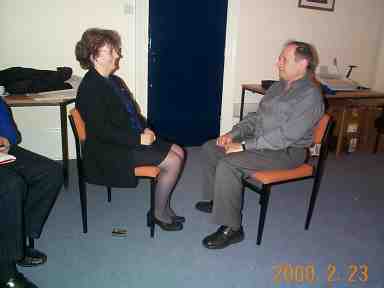 |
|
Margaret Hallsworth and Joe Sinclair demonstrating a co-counselling session in Feb 2000 to the Dorset Association of Complementary Practitioners and the keen subjects dutifully joining in the exercise.
References:
http://homepages.ihug.co.nz/~jnheron/98manual.htm
Booklist:
Rose Evison and Richard Horobin, How to Change Yourself and Your World, Co-Counselling Phoenix, Sheffield, 1983.
Harvey Jackins, The Human Side of Human Beings, Rational Island, Seattle, 1986 (17th edition)
John Southgate and Rosemary Randall, The Barefoot Psychoanalyst, Gale Centre Publication, 1989
Joe Sinclair & Michael Mallows, Peace of Mind is a Piece of Cake, Crown House, 1998 (Chapter 6)
Reversal
Theory (RT) challenges many mainstream assumptions about how and why we behave the way we do. Most
psychological theories of emotional and mental states assume a relatively smooth
and linear functioning. RT describes instantaneous switches, i.e. reversals,
between pairs of incompatible states. That is, RT posits bistability as opposed
to homeostasis because, rather than simply deviating from a basic state of
being, a core identity so to speak, we can, and frequently do, make sudden
switches or reversals between two discrete points or states.
The theory, developed by Dr Richard Apter, presents eight ways of being: four pairs These are labelled Telic / Paratelic - Mastery / Sympathy - Autic / Alloic - Conformist / Negativist.
TELIC / PARATELIC
In the telic mode we are serious and focused on some end result, so we are willing to defer gratification. In the paratelic mode we are less serious and less willing to focus on the future. We want instant gratification.
MASTERY / SYMPATHY
In the former, we filter everything through a win or lose paradigm. In the latter, we experience and express a co-operative, give and take relationship.
AUTIC / ALLOIC
Autic mode is concerned with self interest, self preservation and meeting one’s own needs. In the alloic mode we identify with and are concerned with the needs and interests of others.
CONFORMIST / NEGATIVIST
In conformist mode, we will adapt to the situation, follow the rules, fit in and comply. Negativistic mode can manifest as rebelliousness, breaking the rules, bidding for independence and individuality.
Instant switches between these poles can create diametrically opposed ways of experiencing and interacting with the world. The sudden changes (reversals) of mood and behaviour can seem inexplicable to self and others.
Witnesses or ‘targets’ of these changes can have reciprocal reversals via feelings of anger, alarm or anxiety, depending on their subjective perception and interpretation of the situation.
So, in the middle of an amicable, give and take debate, even with someone we care about, we may suddenly and unexpectedly experience a switch and start arguing as if ‘winning’ the argument really matters. Our heart may beat a little faster, our breathing become a little shallower, our voice may become a little louder, a trifle more aggressive in tone.
We are now in Win/Lose mode and our friend is now an ‘opponent’.
It feels as if survival depends on getting the better of the other person, or at least not ‘losing’ the argument.
This perception is reinforced by the sudden, and from our perspective, uninitiated and unreasonable change of attitude in others. They are suddenly antagonistic, dogmatic and demanding, inaccessible and accusatory; I was not shouting, you never listen!
It goes without saying that there are many combinations and variations of the eight different types.
SUB-PERSONALITIES
Reversal Theory is a structural, phenomenological theory of human action, concerned with subjective rather than behavioural processes and with the experience of one’s own motivation.
If, for example, we are in paratelic, alloic, sympathy modes (combined), we will more readily make or suggest suggestions for shared activities that are exciting and fun.
In combined telic, autic, conformist modes, we may neither consider nor accept such activities because we have task to complete or deadline to meet.In the first we are motivated toward the pleasure and fun of companionship.In the latter we are more focused on some future outcome. It may well be that our commitment reaches satiation and we switch: “I’ve done two hours, I deserve a break! Now, where did my mates say they were going to party? Just one little drink won’t do any harm”
In effect, RT portrays each of us as a set of identities, personas or sub-personalities with no uniform field of continuous consciousness, no ‘single self’ coordinating the crowd. Many of these sub-personalities were imposed (‘scripted’) by the demands and pressures of parents, programmed by the actions and reactions of siblings, moulded by the expectations of mates and mentors, modified by the looks and laughter of enemies – and friends, reinforced by the ridicule of teachers and confirmed by the kicks and kisses of society in general. All this is further compounded by our own confused and confounded thinking.
Charles Tart PhD1 says:
"We just assume that a given person is relatively consistent with himself, that he constitutes one person with various characteristics, traits and so on. Thus you call yourself by one name, with the implication that you are indeed on person even though you have a range of moods and feelings…we actually have many discrete sub-personalities, each of which calls itself ‘I’ when it happens to be activated by appropriate environmental stimuli, but we have no unity of personality at all except in the sense that all the various sub-personalities are associated with the same physical body and name."
Tart also refers to ‘state-dependent memory’ where information learned in one state may be difficult to access whilst in a different or altered state. Different issues and challenges bring forth different personalities, each in effect occupying its own invisible box with no single personality in overall control remembering and coordinating all the roles. This has obvious and interesting implications for nurturing our own and other people’s potential.
RT is a way of understanding, or at least partially explaining subjective experience and the degree to which we get emotionally engaged or detached at any given moment. It helps makes sense of people’s passion for arguments, our dedication to causes and campaigns, a total allegiance to a gang, church, football team or sect. It can shed light on cult worship, gang warfare, ‘mob-mindedness’, teenage rebelliousness, hyper-activity, attention deficit behaviours, as well as atypical or ‘odd’ behaviour.
These eight modes offer an incredible variety and combination of ways to interpret thoughts, feelings and behaviours. Combined with the many other models of character, theories of personality development, motivation, identity formation and so on, there is a vast richness and abundance.
AROUSAL STATES
Arousal states are ways of responding to events and experiences. For example, because we want the pleasant sense of achievement at overcoming a fear, we may seek the adrenalin rush of dangerous, high risk activities.
Arousal levels in either state can be equally high - unpleasant anxiety (fear) or very pleasurable and thrilling (achievement) – but they will be experienced as one or other, never both.
PSYCHOLOGICAL REVERSAL
Reversal theory reflects this phenomenon of experiencing the same things in two opposing ways. You probably know those drawings depicting two images in one where you can see either one or another image e.g. an old and/or a young woman, a rabbit and/or a duck. Or the magic-eye pictures that have images ‘hidden’ in the dots? Some people ‘get it’ straight away, others can’t get it at all, or certainly not both simultaneously. Other examples of reversal psychology are manic-depressive psychosis where a person can switch between diametrically opposed personal ‘maps’ or behaviours. Another is the fluctuation between fear and exhilaration when our ‘plane takes off.
What triggers or arouses us to react in certain ways? What prompts anger or anxiety? What stirs love or laughter? What provokes hubris or hurt, towards or away from behaviours, longing or loathing, ambition or apathy?
The answers are as varied and numerous as there are people or moments. It can be very useful (and profitable) to know how to determine these answers when assessing people in professional or personal terms. Will they fit in as a team player? Are they appropriate people to adopt or foster children? Could they be suitable candy dates for a mating agency?? Will I overwhelm or undermine that individual? Is this person likely to motivate or demotivate me?
Some theorists emphasise the motivational process itself and our basic needs for affiliation, nurturance and so on. Others concentrate on non-biological or particularly human motivations such as power and achievement. Reversal theory emphasises the way that motivation fluctuates and changes and how these changes influence our perceptions and interactions.
References:
1 Charles Tart, Transpersonal Psychologies (1975).
Booklist:
Apter, Michael J. Reversal Theory: Motivation, Emotion, and Personality. London/New York: Routledge, 1989.
Back to:
Co-Counselling and